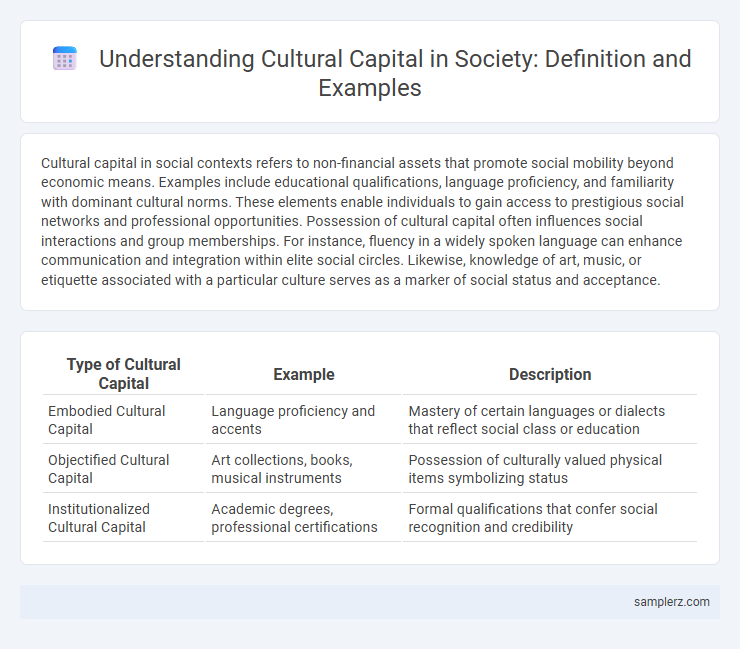Cultural capital in social contexts refers to non-financial assets that promote social mobility beyond economic means. Examples include educational qualifications, language proficiency, and familiarity with dominant cultural norms. These elements enable individuals to gain access to prestigious social networks and professional opportunities. Possession of cultural capital often influences social interactions and group memberships. For instance, fluency in a widely spoken language can enhance communication and integration within elite social circles. Likewise, knowledge of art, music, or etiquette associated with a particular culture serves as a marker of social status and acceptance.
Table of Comparison
| Type of Cultural Capital | Example | Description |
|---|---|---|
| Embodied Cultural Capital | Language proficiency and accents | Mastery of certain languages or dialects that reflect social class or education |
| Objectified Cultural Capital | Art collections, books, musical instruments | Possession of culturally valued physical items symbolizing status |
| Institutionalized Cultural Capital | Academic degrees, professional certifications | Formal qualifications that confer social recognition and credibility |
Understanding Cultural Capital in Social Contexts
Cultural capital in social contexts includes non-financial assets such as education, language proficiency, and social etiquette that influence an individual's social mobility and acceptance. Mastery of cultural norms and access to historical knowledge enables individuals to navigate social institutions more effectively. These elements help shape social networks and reinforce social stratification within communities.
Everyday Examples of Cultural Capital in Communities
Everyday examples of cultural capital in communities include knowledge of local customs, language proficiency, and participation in traditional events, which enhance social cohesion. Access to cultural institutions like libraries, museums, and theaters further enriches individuals' cultural capital by providing learning opportunities and social networks. Skills such as etiquette, communication styles, and educational qualifications also serve as cultural capital that influences social mobility and community engagement.
Language and Communication as Forms of Cultural Capital
Language proficiency and communication skills serve as key forms of cultural capital, enabling individuals to navigate diverse social settings and access elite networks. Mastery of dominant languages and nuanced communication styles enhances social mobility and influence within professional and academic environments. These competencies often reflect and reinforce underlying power structures by facilitating cultural belonging and social recognition.
Educational Attainment as Cultural Capital
Educational attainment exemplifies cultural capital by equipping individuals with knowledge, skills, and credentials that enhance social mobility and access to resources. Higher levels of education often correlate with improved job prospects, increased income, and expanded social networks, which further reinforce societal advantages. This form of cultural capital shapes social identity and influences one's ability to navigate and succeed within various social institutions.
Art, Music, and Literature in Social Life
Cultural capital in social life manifests through engagement with art, music, and literature, which shape individuals' identities and social status. Mastery and appreciation of classical art forms, musical instruments, and literary works often signal higher cultural competence and social distinction. Participation in cultural activities such as gallery visits, concerts, and literary festivals enhances social networks and reinforces societal hierarchies.
Family Traditions and Cultural Capital Transmission
Family traditions serve as a vital form of cultural capital by preserving values, customs, and language that shape social identity and cohesion. Through rituals, storytelling, and shared practices, families transmit cultural knowledge that enhances social networks and opportunities for future generations. This intergenerational transfer of cultural capital strengthens social mobility by embedding cultural competencies within familial contexts.
Social Etiquette and Manners as Cultural Assets
Mastery of social etiquette and manners serves as a vital form of cultural capital, shaping individuals' ability to navigate various social environments with ease and respect. Politeness, appropriate greetings, and conversational norms act as intangible assets that influence social acceptance and upward mobility. Understanding these social codes enhances interpersonal relationships and access to exclusive networks, underscoring their role as valuable cultural capital.
Cultural Capital in Networking and Social Mobility
Cultural capital in networking and social mobility includes skills, knowledge, and social cues that facilitate access to influential social circles and professional opportunities. Examples encompass mastery of etiquette, language proficiency, and familiarity with dominant cultural references, which enhance trust and acceptance within elite groups. This form of capital directly impacts an individual's ability to navigate social hierarchies and improve their socioeconomic status.
Dress Codes and Appearance in Social Interaction
Dress codes and appearance play a crucial role as forms of cultural capital in social interactions, signaling group membership and social status. For example, wearing tailored suits or designer brands often conveys professionalism and wealth, while adherence to specific grooming standards can indicate belonging to a particular cultural or professional group. This presentation of self influences social acceptance, access to opportunities, and interpersonal relationships within various social contexts.
The Role of Cultural Capital in Shaping Identity
Cultural capital, including education, language proficiency, and familiarity with cultural codes, plays a crucial role in shaping individual identity within social contexts. Access to cultural capital influences social mobility and the ability to navigate various social institutions, reinforcing class distinctions. This dynamic highlights how cultural knowledge and practices contribute to the formation and expression of personal and group identities.

example of cultural capital in social Infographic
 samplerz.com
samplerz.com